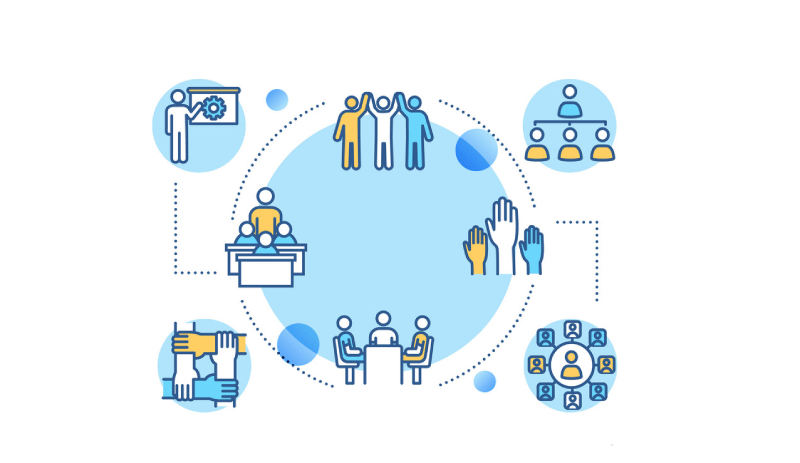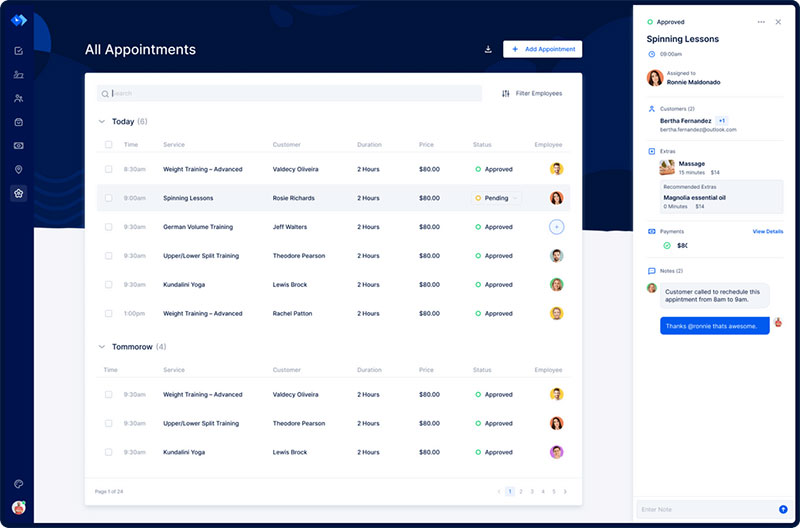Industries today are ever-evolving. Technology, staff roles, work processes, and equipment keep developing, so companies deal with an unprecedented level of competitiveness.
Starting a mentoring program is key to generating efficient teams and healthy work environments. This initiative helps to close the gap between staff with more responsibility and lower-ranking workers.
Senior employees need to adapt to new methodologies and equipment. On the other hand, new hires also require support during onboarding and throughout their careers.
Regardless, providing a mentoring program can be a perplexing and challenging process. It is a time-consuming task that requires considerable effort.
In this article, you will learn about the advantages of opting for this type of guidance. You will also be able to understand the essential steps to assembling and maintaining it.
Scroll down to find all the details about why and how to start a mentoring program in your company.
Why Foster a Mentorship Program?
A mentorship program includes two main parties, the mentor and the mentee. The people involved in this type of relationship tend to form close bonds.
They support each other through a long-lasting partnership. They share goals and achievements but also challenges and struggles.
Traditional mentors are experienced employees who have worked in a specific field or company. Their mastery and training have prepared them to help others grow in their area of expertise or organization. They feel more valuable by embracing a new function and learning new skills.
Mentees tend to be newer staff members. They might have recently graduated from college and started an internship. Maybe they are in their onboarding process. Or they might have signed up for a specific training proposed by the business. Therefore, their mentors provide the emotional and technical backing they need.
There are significant advantages for all parties. Even those who are not directly connected to the mentoring relationship may benefit from it.
Mentoring ensures the training of organizational leaders for the future. It opens opportunities for growth within the company. Employees become more invested and motivated, so retention and structural stability increase. Mentorship also reduces business costs in the long term.
Below you will find a detailed eight-step guide on how to start a mentoring program.
Eight Steps to Start Your Mentoring Program
The guide below focuses on organizing, establishing, and maintaining a successful mentoring program. Adopting this strategy will help you manage expectations and promote accountability.
The eight crucial steps are
- Set your intent and define specific objectives
- Determine a type of mentorship
- Define the particulars for your program
- Get employees to enroll in your mentoring program
- Match the participants for each mentoring relationship
- Provide training for mentors and mentees
- Guide the mentoring relationships
- Assess and register the results
Set your Intent and Define Specific Objectives
The first stage of any mentoring program is to set the outcome you want to achieve. There are many factors to consider when embracing a project like this one.
Having a defined and precise intent will serve as guidance throughout the process. It will be helpful for you and the participants.
You must specify the issues you want to approach. Define the type of support you are looking to provide. Additionally, fix parameters to evaluate progress. Doing so will supply a solid and sustainable structure for your plan.
Another vital aspect is considering organizational goals. Each company has its standards, ambitions, and concerns. A mentoring program without any added value for the business would not be worth the time and money invested.
Besides, try to understand the viewpoint of your employees and interns. The participants will have expectations and objectives they would like to fulfill. They ought to feel that there are some benefits to compensate for the effort they will make.
When setting up mentoring programs, you must merge the interests of your business with the interests of the participants of the program. Everyone involved must know and relate to the program's goal and format.
Invest a reasonable amount of time in these matters. They will help you create a more complete and transparent operation. Ponder using some type of mentoring software. Doing this will give you confidence and direction as you develop and go through each stage.
You will have the capacity to work towards your goals and see more impactful results. The care you put into this project will also attract more willing participants.
Determine a Type of Mentorship
There are several directions a mentoring program can take. Program administrators should evaluate the needs of the business and employees. Then, you will be able to choose the most suitable solution.
Consider the following options.
One-on-One Mentoring

One-on-one is the standard mentoring process. It pairs each mentee with a particular mentor. Then, they work together to identify and approach specific concerns or develop certain skills.
Despite being more traditional, this program still offers notable advantages. It improves staff retention rates and promotes professional development within the organization.
Group Mentoring

In a group setting, there are several mentees to one mentor. Like the traditional method, they follow a schedule and have regular meetings.
There will be more benefits if the groups are kept small. This way, mentees can feel more comfortable speaking about their struggles. It also allows the mentor to offer tailored advice to the participants.
Group mentoring programs promote bonding between colleagues and boost employee engagement.
Peer-To-Peer Mentoring
In a peer-to-peer system, mentees are also each other's mentors. Program participants are on the same level within the organizational structure. Thus, they train and, at the same time, learn from their coworkers.
You can get very positive outcomes by investing in such a program. It promotes unity in teams and departments and encourages personal development.
Employee Resource Groups
A resource group is not a mentorship program. But it is a valuable initiative that improves employee satisfaction.
Creating these teams promotes bonding between workers with similar characteristics and challenges. Especially in some industries, it makes sense to provide this type of help to your workforce.
Reverse Mentoring
Organizational leaders understand the importance of training workers with managerial aptitudes. These are the ones who will take on leading roles in the future.
In the reverse mentoring method, the mentee shares their knowledge, skills, and viewpoints. They get the support they need while also training and assisting the mentor.
Flash Mentoring
Flash mentoring develops in brief, regular meetings during a short period. These mentorship programs focus on developing specific skills or overcoming particular challenges.
Since it is a fast process, there is no need for a deeper human connection. Meetings can be held in person or through virtual means. Whatever the primary concern, the approach is straightforward, and the progress schedule is strict.
Your mentorship success story starts with a scheduling app to streamline your calendar
Staying organized has never been easier.
You can now manage your business and grow your brand with a single, powerful software that keeps all of your appointments in line, your clients organized and your business booming.
Trafft is perfect for business owners who need to streamline their booking experience both for their staff and their clients.
Trafft handles everything for you, even sending automated email or SMS reminders to your clients. No-shows? Not anymore!
The Trafft booking software adapts to different industries for a blissful online booking experience and employee management.
Want to know more? Check out Trafft's awesome features to see what you are missing.
Define the Particulars for Your Program
You need to define a solid structure for your mentoring program. Hence, in this third step, you will establish the details of your project.
Besides outlining the basic guidelines, you must be precise when designing the process. Set realistic expectations for mentors and mentees and specify an ideal outcome. Consider the following aspects.
Extent and Progress
You must fix the duration of the program and schedule regular audits. Define accurate criteria to monitor progress. Then, prepare strategies to apply if the advancement does not correspond to the expectations.
Who Will Participate and How
Settle to whom the program will be available and how those interested can enroll. Choose a program manager and instruct how you want to promote the program to reach the intended employees. Also, determine how many mentors and mentees the program will include.
The Program Itself
You need to clarify what kind of mentoring relationships you want to foster and how. Create a strategy that meets the goals of both the program participants and the business.
Costs and Other Elements
As you develop your approach, keep in mind that mentoring should be flexible. You can blend different learning styles and techniques to achieve better results.
Also, learn how to toe the line between keeping the mentoring program cost-effective but still impactful on the organization.
Remember, everyone should know what to anticipate and what expectations they must meet. Thus, keep all information available to all workers, including non-participants.
If you opt for an automated solution with mentoring software, it will be easier to maintain transparency.
Get Employees to Enroll in Your Mentoring Program
Workplace mentoring programs are exciting opportunities. However, to achieve high participation rates, you need a planned promotion strategy.
You can make the program available for enlistment or opt for an invitation-only system. Be aware that an open policy involves more investment in promoting the operation and its advantages for workers.
Moreover, in a more rigid approach, you should be mindful when selecting program administrators. With this method, purposeful, selective recruitment will be essential for success. So they should be capable of identifying potential mentors and mentees.
Either way, choosing program managers is a delicate task. Consider their abilities, competencies, and reputation among their colleagues.
Participants ought to understand the mentoring program and its benefits. Therefore, try to present your plan in a way that highlights how it will promote their goals and career development.
As you encourage employee engagement, you should remain open to their suggestions and opinions.
One of the most important aspects is to get key stakeholders on board. If workers see that others support the initiative, they will feel more motivated to take part.
Match the Participants for Each Mentoring Relationship
This step is one of the most challenging for HR professionals managing a mentoring program. It requires deep knowledge of all participants, including their career goals and difficulties.
As you create work teams or pairs, remember they will partner for an extended period. Your aim is for them to create a healthy bond through which to grow and benefit the organization.
Match mentors and mentees who will truly help each other. Consider their expertise, pursuits, and interests, while also respecting their personality, background, and ambitions.
There are four crucial factors. Reflect on them to understand how these elements can benefit your mentoring program.
Seniority
If you are executing the mentoring program within a big corporation, you can start with the senior level. With several managerial ranks, bonding and efficient cooperation can be difficult.
Pairing mentors and mentees with high grades of responsibility will close that gap. Lower-position employees will also feel encouraged to take part when the opportunity arises.
Personality
A mentoring relationship will only be successful if both the mentor and the mentee are willing to strive for growth. They must be aware of their abilities and keen to work on their concerns.
Proactive personalities are outstanding to have in a mentorship program. Not only do they ease the process, but they also make a good match with almost anyone.
Willingness to Participate
You do not want to force employees to be part of your mentoring program. Instead, you want to encourage them to do so. It is the only way for results to equal the time and effort of all participants.
Besides, allowing workers to choose to enlist (or not) shows respect for the work they already do within the organization.
Diversity
Mentorship programs are opportunities to create more inclusivity and diversity in a company. Match mentors and mentees with various backgrounds and provide thoughtful support for minorities.
Provide Training for Mentors and Mentees
At this step, the program managers provide support for those partaking in the program. They should supply various resources to assist throughout the process.
Using mentoring software that pairs mentors and mentees is less time-consuming. Although, you should allow them a period to get to know each other. Doing so will help you discern if they fit as partners.
Likewise, it will enable the mentor to understand if they have the abilities required and, if so, decide which training techniques could lead to success.
Nevertheless, all workers will gain more focus and confidence. Everyone will be better prepared to receive and offer training.
The instruction during this stage directs mainly toward mentors. They have the most responsibility within the relationship. Therefore, they should establish an environment that fosters skill-building.
Hence, a self-matching policy may not be the most successful approach in the long term. Sticking to the structure created will keep the program organized and simplify management.
Program participants must understand their roles, responsibilities, duties, and rights.
Guide the Mentoring Relationships
Mentoring programs demand consistent, regular guidance. You have prepared a detailed plan and have recruited employees for your program. Afterward, you matched mentors and mentees and offered them the needed instruction. However, now you must track their progress.
The truth is that most employees are not used to training on a day-to-day basis. Thus, it's easy to settle into a routine and disregard the mentoring program not long after becoming a participant.
It can be tiring to merge their everyday tasks with the demands of partaking in the program. Hence, be prepared to encourage mentors to strive for success and meet the needs of their mentees.
Motivate them to follow the structure established. Remind them of the benefits the partnership can have, despite the difficulties. And be prompt to aid them in developing strategies that sustain improvement.
Regular check-ups can help you identify any issues or inconsistencies that might surface. Even if you have little time, seek to maintain frequent conversations with all participants.
This way, you will be showing personal interest in their growth. They will feel at ease to share any struggles they might face during the mentoring program.
Another valuable idea is to create a community among participants. Schedule meetings where they can gather and talk about their mentoring experience. It will help them keep responsibilities in mind and remain accountable for fulfilling them.
Assess and Register the Results
The final stage of how to start a mentoring program involves planning regular evaluations. This process can become less complex if you apply specific mentoring software.
Therefore, you will accompany progress, maintain focus, and know when to apply corrective measures. The following are some of the standard criteria.
Participation Rates
The first parameter applies as you are first starting a mentoring program. Assess how much interest employees have in your project. Consider how the participants complement each other regarding abilities, personalities, and challenges.
If participation rates are low, study a different promotion tactic or try to enlarge your audience.
Goal Achievement
Keep track of which goals your participants are achieving through the mentorship program. If you identify a problem in any relationship, be flexible to changes that offer a better chance of success.
Individual Feedback
Create opportunities for participants to provide feedback. Make them feel comfortable sharing their personal experience in casual conversations. You will get a better insight into how the mentoring program is evolving.
Session Feedback
On a formal basis, you can use meetings to ask for program feedback. Instead of consulting with each mentor and mentee, you might use a written form.
It will help you understand if the mentoring is meeting their expectations. From there, you will develop strategies to improve for future cohorts.
Business Outcomes
The mentorship program should also benefit the company. Key stakeholders and corporate leaders must feel that the results will be worth the time, effort, and money invested.
Keep track of several standards, such as retention and promotion rates.
FAQs about starting a mentoring program
1. What are the key benefits of having a mentoring program in our organization?
Employees that participate in mentoring programs gain helpful advice, support, and feedback on their professional growth, among other advantages.
Employees' job performance can be improved, their knowledge and skills can grow, and their job happiness and retention can rise thanks to mentoring.
Moreover, mentoring programs can promote a culture of education and growth inside an organization, which can enhance general worker satisfaction and productivity.
2. How do we identify and select the right mentors for our program?
For a program to be successful, the correct mentors must be found and chosen. The goals and desires of the mentee should be compatible with the abilities, expertise, and experience of the mentor.
Also, they should be devoted to the mentoring relationship and possess strong interpersonal and communication skills as well as the ability to offer constructive criticism.
Potential mentors can be found by organizations through a variety of techniques, including employee recommendations, internal talent assessments, and job performance reviews.
3. What are the best practices for designing a mentoring program that aligns with our organizational goals and values?
Many best practices must be used to create a mentorship program that is in line with the objectives and core values of the organization.
The program should be created to specifically address the needs and objectives of the organization and have clearly stated objectives, such as increasing employee engagement or boosting job performance.
The program should be well-structured, with clear objectives and standards for participants, and mentors and mentees should be paired according to their abilities, interests, and aspirations.
4. How do we match mentors and mentees effectively to ensure a successful mentoring relationship?
Effective mentor-mentee matching is essential to a mentoring relationship's success.
The aims and aspirations of the mentee, the mentor's expertise, and the compatibility of the mentee and mentor's personalities and communication styles are all things that organizations should take into account.
In order to help mentors and mentees set clear expectations and goals for their relationship as well as to develop good communication and feedback, organizations should also offer training and support.
5. How do we measure the success of our mentoring program and track its impact on our employees?
Monitoring important metrics, such as employee engagement, job performance, and retention rates, as well as getting participant feedback are necessary to evaluate the effectiveness of a mentoring program.
Companies can also hold focus groups and surveys to get more in-depth input on how the program is affecting the workforce.
Organizations can discover areas for improvement and modify the program to better suit participant requirements by conducting regular program evaluations.
6. What kind of training and support should we provide to our mentors to help them succeed in their roles?
To ensure that mentors are successful in their roles, training, and assistance are essential. Training should be provided to mentors on effective mentoring methods, communication tactics, and how to set up specific objectives and expectations for the mentoring relationship.
Additionally, organizations can offer mentors ongoing assistance by giving them the opportunity to connect with other mentors and discuss best practices as well as regular check-ins with program managers.
7. How do we address potential challenges and conflicts that may arise during mentoring relationships?
Effective communication and conflict resolution techniques can be used to resolve any issues that might come up during mentoring relationships.
From the start, mentors and mentees should be encouraged to communicate openly and honestly with one another as well as to have clear expectations and goals for the partnership.
Organizations should offer mentors and mentees assistance and tools to help them deal with problems when they do occur and seek to find a solution.
8. How do we maintain momentum and engagement in our mentoring program over time?
Program managers must put in constant work and focus to keep a mentoring program moving forward and keeping participants engaged.
Participants in the program can be kept engaged and committed through regular interaction and communication. Companies may also think about providing rewards and recognition to individuals who excel in the program and show extraordinary devotion.
Organizations should also assess the program's effectiveness on a regular basis and alter it as necessary to ensure that it continues to meet the changing demands and objectives of the company and its staff.
9. How do we ensure confidentiality and trust between mentors and mentees?
The viability of a mentoring relationship depends on maintaining trust and secrecy between mentors and mentees. Organizations can set precise confidentiality rules and regulations and make sure that mentors and mentees are aware of and accept these rules.
In addition, open and honest communication as well as respect for one another's boundaries and privacy should be fostered between mentors and mentees.
10. How can we encourage and promote diversity and inclusivity in our mentoring program?
In a mentorship program, encouraging and supporting diversity and inclusivity can assist make sure that every employee has equal access to helpful advice and support.
The objectives and activities of mentoring programs can be inclusive and relevant to all participants, and organizations should actively seek out mentors and mentees from varied backgrounds, among other measures, to promote diversity and inclusivity.
In order to help mentors and mentees successfully manage diversity and inclusion concerns, organizations can also offer training and support.
Ending Thoughts on How to Start a Mentoring Program
Starting a mentoring program can be an elaborate task, especially in big organizations. Yet, it is the best way to improve employee retention rates and satisfaction.
The success of any enterprise depends on having balanced, efficient work teams. You need your employees to feel valued and acknowledged. Then, they will bring even more benefits to the business.
This article shared an eight-step guide on how to start a mentoring program. You might still be planning to propose this initiative to the administration, or you might have already started developing it. At any rate, take time to analyze each of the stages described above.
As all companies are different, you may need to add steps, or you can simplify any of the ones above. However, you will get fantastic results if you follow a structured program.
If you enjoyed reading this article about successful mentoring, you should read these as well:
- The Most Useful Mentoring Agreement Templates and Examples
- Top Mentoring Tools and Apps to Make A Lasting Impact
- The Mentoring Expectations for the Mentor and Mentees







